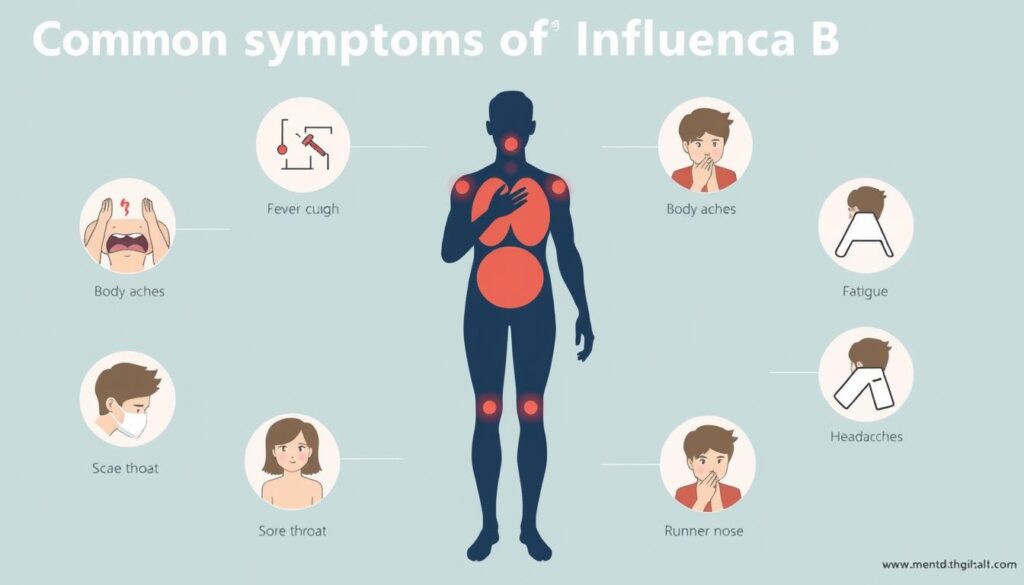Flu season brings a critical need to understand influenza B symptoms. This specific flu virus has unique traits that can impact your health unexpectedly1.
Influenza B targets your lungs, nose, and throat. It causes about 23% of global flu illnesses but can have significant effects1.
Symptoms usually show up 1-4 days after exposure. They can range from mild to severe2.
Your risk of serious complications depends on several factors. Young children, older adults, and those with chronic health issues are at higher risk1.
Key Takeaways
- Influenza B affects approximately 23% of global flu cases
- Symptoms typically appear 1-4 days after exposure
- High-risk groups include young children and older adults
- Respiratory system is primary target of infection
- Vaccination can reduce flu risk by up to 60%
Understanding Influenza B and Its Impact
Influenza B is a unique respiratory virus that only affects humans. It’s different from influenza A and can cause tough symptoms. The virus spreads quickly through respiratory droplets, making it very contagious3.
Influenza B is limited to human hosts and usually causes milder symptoms than influenza A. However, it can still lead to significant health complications. Knowing about this virus helps protect you and your loved ones.
“Knowledge is the best defense against influenza B” – CDC Infectious Disease Expert
- Exclusive to humans
- Spread through respiratory droplets
- Can cause severe symptoms in high-risk populations
Influenza B causes about 23% of flu cases worldwide3. It can trigger common flu symptoms like high fever and breathing problems4. Kids often get hit hard, with fevers reaching 103 to 105 degrees Fahrenheit3.
| Characteristic | Influenza B Details |
|---|---|
| Host Range | Humans Only |
| Global Prevalence | 23% of Flu Cases |
| Typical Fever Range | 103-105°F |
Most people recover from flu symptoms in 3-7 days4. But some might have a cough and feel tired for over two weeks4. Knowing these symptoms helps you get medical help when needed.
Influenza B Symptoms
Influenza B can hit fast, affecting both adults and kids with clear signs. Knowing these symptoms helps you spot and tackle the virus quickly5.
Primary Symptoms of Influenza B
Flu B brings on sudden, tough symptoms. The main signs often include:
- High fever reaching up to 106 degrees Fahrenheit
- Intense body aches and muscle pain
- Severe headache
- Extreme fatigue
- Nonproductive cough
Flu B often causes sore throat, runny nose, and congestion6. These signs can last 3-7 days, sometimes longer in older folks5.
Secondary Symptoms and Complications
Kids may show extra flu B signs different from adults:
- Irritability
- Ear pain
- Gastrointestinal issues like nausea and diarrhea6
Serious problems can arise, including:
- Pneumonia
- Bronchitis
- Sinus infections
- Potential neurological complications5
Some groups risk worse flu B symptoms. People with asthma, diabetes, or heart disease face higher dangers5.
Get help fast if you have trouble breathing, chest pain, or confusion6. These are emergency signs.
Early recognition of flu B symptoms can significantly improve treatment outcomes and reduce potential complications.
Treatment Options and Prevention Strategies
Managing flu B virus symptoms requires understanding your treatment options. The main goal is to ease symptoms and avoid complications. Antiviral medications can be crucial in treating flu B, especially when started early7.
- Rest and plenty of fluids
- Over-the-counter pain relievers
- Antiviral medications when prescribed
Most people manage flu B with specific treatments. Antiviral drugs can lessen symptoms and shorten illness time7. The CDC advises yearly flu vaccines as the main prevention method8.
“Early treatment is key to managing influenza effectively”
Medications like oseltamivir and zanamivir can fight the flu B virus. These work best when taken within 48 hours of symptoms starting7.
| Prevention Strategy | Effectiveness |
|---|---|
| Annual Vaccination | Highest Protection |
| Hand Hygiene | Moderate Protection |
| Avoiding Close Contact | Good Protection |
Everyone 6 months and older should think about getting vaccinated. This can lower flu risks significantly8. Using these strategies can help you manage and prevent flu B virus symptoms effectively8.
Conclusion
Knowing influenza B symptoms helps protect you and your loved ones. While milder than influenza A, it still needs careful attention. The Centers for Disease Control and Prevention advises staying alert to early infection signs910.
Prevention is your best defense against influenza B. Yearly flu shots are vital, especially for high-risk groups. These include young children, older adults, and those with chronic health issues9.
Vaccination lowers your chances of getting the virus. It also reduces potential complications if you do get infected10.
Seek medical help quickly if you have flu B signs. These include sudden fever, body aches, or breathing problems. Early antiviral medications can speed up recovery9.
Most flu B symptoms clear up within two weeks. Staying informed and proactive is crucial for your health during flu season10.
Understanding flu B and taking preventive steps protects you and your community. Get vaccinated and take care of yourself during flu season.
FAQ
What is Influenza B?
What are the most common symptoms of Influenza B?
How does Influenza B spread?
Who is most at risk for severe Influenza B complications?
How can I treat Influenza B symptoms?
Can I prevent Influenza B?
How long are Influenza B symptoms typically contagious?
When should I seek medical attention?
Source Links
- Influenza B Symptoms: Respiratory, Body, Stomach – https://www.healthline.com/health/influenza-b-symptoms
- 13 Signs of Influenza (Flu) B Everyone Should Know – https://www.health.com/condition/flu/what-is-influenza-b
- What Is Influenza B? – https://www.verywellhealth.com/flu-b-symptoms-identify-treat-and-prevent-5216276
- Clinical Signs and Symptoms of Influenza – https://www.cdc.gov/flu/hcp/clinical-signs/index.html
- It Might Not Be ‘Just a Cold’: 8 Signs You Actually Caught Influenza B – https://www.health.com/influenza-b-8413847
- Influenza (flu) – Symptoms and causes – https://www.mayoclinic.org/diseases-conditions/flu/symptoms-causes/syc-20351719
- Influenza Treatment – https://www.niaid.nih.gov/diseases-conditions/influenza-treatment
- Preventing Seasonal Flu – https://www.cdc.gov/flu/prevention/index.html
- Influenza B symptoms: Symptoms, treatment, and prevention – https://www.medicalnewstoday.com/articles/326679
- Influenza A vs. B: Differences, symptoms, treatment, and more – https://www.medicalnewstoday.com/articles/327397
